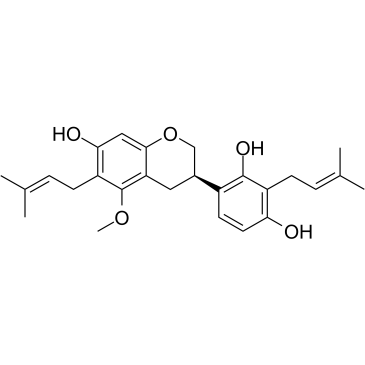| Description |
Licoricidin (LCD) is isolated from Glycyrrhiza uralensis Fisch, possesses anti-cancer activities.Licoricidin (LCD) inhibit SW480 cells (IC50=7.2 μM) by inducing cycle arrest, apoptosis and autophagy, and is a potential chemopreventive or chemotherapeutic agent against colorectal cancer[1].Licoricidin (LCD) inhibits Lung Metastasis by inhibition of tumor angiogenesis and lymphangiogenesis as well as changes in the local microenvironment of tumor tissues the anticarcinogenic effect[1].licoricidin enhanced gemcitabine-induced cytotoxicity in Osteosarcoma (OS) cells by inactivation of the Akt and NF-κB pathways in vitro and in vivo[3]. Licoricidin blocks UVA-induced photoaging via ROS scavenging, limits the activity of MMP-1, it can be considered as an active ingredient in new topically applied anti-ageing formulations[4].
|
| Related Catalog |
|
| In Vitro |
Licoricidin (LCD) (0-20 μM; 24 hours) dose-dependently inhibits the viability of colon cancer cell lines with various pathological and genetic characters, namely SW480, HCT116, SW620 and LoVo cells, with IC50 values of 7.2, 5.4, 4.5 and 5.1 μM, respectively[1]. Licoricidin (LCD) (0-20 μM; 0-12 hours) induces cell apoptosis was accompanied with the activation of caspase-3 by cleavage in a time- and dose-dependent manner[1]. Licoricidin (LCD) (0-20 μM; 0-12 hours) induces autophagy of SW480 cells, increases the cleavage of LC3-I to LC3-II and the degradation of p62 in a time and dose dependent manner[1]. Licoricidin (LCD) (0-5 μg/ml; 18 hours) inhibits cell migration, MMP-9 secretion, and VCAM expression in 4T1 cells[2]. Cell Viability Assay[1] Cell Line: SW480, HCT116, SW620 and LoVo cells Concentration: 0-20 μM Incubation Time: 24 hours Result: Decreased colon cancer cell lines viability. Western Blot Analysis[1] Cell Line: SW480 cells Concentration: 0 μM, 2.5 μM, 5 μM, 10 μM, 20 μM Incubation Time: 0 hours, 1 hour, 3 hours, 6 hours, 12 hours Result: Induced cell apoptosis.
|
| In Vivo |
Licoricidin (LCD) (intraperitoneal injection; 5, 10, or 20 mg/kg; once daily; 15 days) significantly inhibited the growth of SW480 xenografts in nude mice with an inhibitory rate of 43.5%[1]. Licoricidin (LCD) (intraperitoneal injection; 5, 10, or 20 mg/kg; once daily; 32 days) reduces pulmonary metastasis and the expression of CD45, CD31, HIF-1α, iNOS, COX-2, and VEGF-A in tumor tissues, additionally, decreases protein expression of VEGF-R2, VEGF-C, VEGF-R3, and LYVE-1 in tumor tissues of licoricidin-treated mice[2]. Animal Model: SW480 xenografted tumor growth in nude mice[1] Dosage: 5, 10, or 20 mg/kg Administration: Intraperitoneal injection; once daily; 15 days Result: Decreased tumor volumes. Animal Model: BALB/c mouse orthotopic model[2] Dosage: 5, 10, or 20 mg/kg Administration: Intraperitoneal injection; 5, 10, or 20 mg/kg; once daily; 32 days Result: Inhibited Lung Metastasis of 4T1 Murine Mammary Carcinoma cells.
|
| References |
[1]. Ji S, et al. Licoricidin inhibits the growth of SW480 human colorectal adenocarcinoma cells in vitro and in vivo by inducing cycle arrest, apoptosis and autophagy. Toxicol Appl Pharmacol. 2017 Jul 1;326:25-33. [2]. Park SY, et al. Licoricidin, an Active Compound in the Hexane/Ethanol Extract of Glycyrrhiza uralensis, Inhibits Lung Metastasis of 4T1 Murine Mammary Carcinoma Cells. Int J Mol Sci. 2016 Jun 14;17(6). [3]. Wang Y, et al. Licoricidin enhances gemcitabine-induced cytotoxicity in osteosarcoma cells by suppressing the Akt and NF-κB signal pathways. Chem Biol Interact. 2018 Jun 25;290:44-51. [4]. Kim KJ, et al. Licoricidin, an isoflavonoid isolated from Glycyrrhiza uralensis Fisher, prevents UVA-induced photoaging of human dermal fibroblasts. Int J Cosmet Sci. 2017 Apr;39(2):133-140.
|
